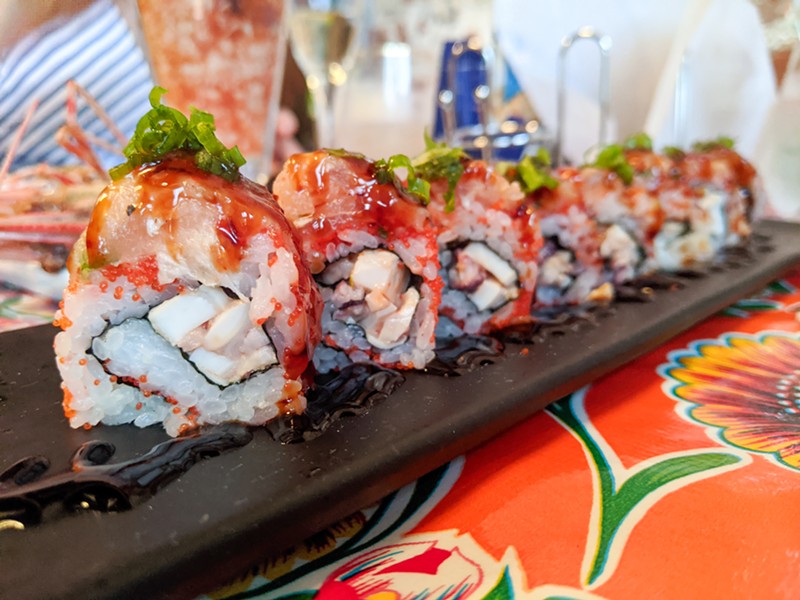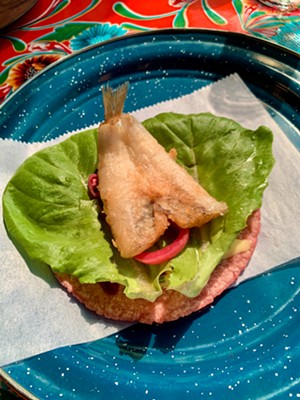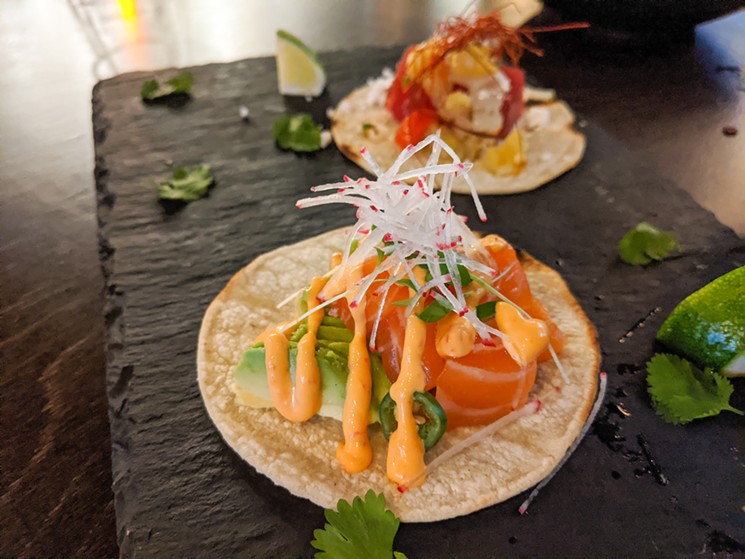One of Dallas’ most famous taco shops is serving sushi rolls. A few miles up the road, a high-quality sushi bar is making tacos.
Has the world turned upside down?
Ask the chefs, and they’ll offer a surprising answer: The connection between Japanese and Mexican food has century-old roots. Tacos and sushi have more in common than Dallasites might think.
Japanese immigrants arrived in Mexico by the thousands in the early 1900s. Later on, Japanese-Peruvian fusion cuisine became famous, courtesy of migrant chefs such as Nobu Matsuhisa. It’s that cross-cultural tradition that is now arriving in Dallas.
Keunsik Lee, the executive chef at Edoko Omakase, worked at Nobu for years, and Revolver Taco Lounge owner Regino Rojas is drawing on Japanese influences in Baja California for his new seafood brunches.
Although fewer Japanese people migrated to Mexico than to Peru or the United States, the arrival of thousands of new Japanese workers, roughly from 1900 to the beginning of World War II, left its mark on Mexican food. That’s especially true of Baja California and the tourist town of Ensenada, where, by 1940, there were several hundred Japanese fishermen and farmers.
Baja, of course, is famous for its battered and fried fish tacos. As Rojas points out, one of the two much-debated theories for the origin of the fish taco is that it started with Japanese cooks using tempura batter.
“I’m not inventing anything, I’m just exposing it to the people,” Rojas says.
The day after I spoke to him last week, he flew to Guadalajara — which is also home to a thriving Thai-Mex food scene — as the first leg of a journey that will take him to Ensenada.
“My inspiration is the locals,” he says about his trip. “There’s no books about it, so you need to talk to vendors, talk to people and analyze why they’re doing this, why you’re doing that, and try to come to your own conclusions, always respecting the technique of the area. It’s following the tradition. I don’t think I’m creating anything. This is nothing new. This is something that’s been in the area for a while.”
Rojas installed a yakitori grill inside his dining room, which is now called La Resistencia and serves taco tastings in the evenings and a-la-carte seafood on weekends. He loves the yakitori grill, which allows him to cook each taco fresh and maintain careful control of smoke and flame to create different textures.
To illustrate the influence Japanese immigrants have had on Mexican tradition, Rojas points to ceviche.
“The fish has to be fresh and not over-marinated,” he says. “You make it in the moment, so only the upper layers get cured in the lime. There’s where you can see the respect to the animal in the culture, and that’s what the Asians brought to us, the respect and the knowledge of how to treat the fish.”
At Edoko Omakase, Lee takes things a step further by adding sashimi and even uni into his tacos. Influenced by his years of training at Nobu and his more than 15 years living in Texas, Lee also works on sauces and garnishes with names like “kimchee de gallo,” based on his observations of intersections between Mexican and Asian cultures.
“Even Nobu restaurants, almost half of employees are from [Latin] America,” Lee says. “Every day we cook a meal for staff, right? One day we cook Asian food, one day they cook Mexican food, so we always have a chance to share our food culture.”
The “kimchee de gallo” idea, for example, came to Lee while he was still in school, sampling tacos and observing the role that pico de gallo plays as a garnish.
“Flavorwise it’s similar,” he says. “Kimchi is sour. Also — most people think about kimchi with red chile, but we have a lot of different kimchi. One kind we have is a white kimchi, we don’t add a lot of chile powder. It’s very similar to the onion marinated in citrus. I came up with the idea with white kimchi replacing diced onions: tomatoes, jalapeños and kimchi instead of onions.”
Similar ideas appear elsewhere on Edoko Omakase’s menu, such as a salsa verde with wasabi. Lee’s signature dish, which he calls “tuna pizza,” is in fact a classical tostada built on a fried tortilla with thinly sliced serrano peppers.
As I finished writing this article, Rojas began texting me photographs from Ensenada: ramen shops, sushi bars, a Korean restaurant advertising “Korean frito chicken” with the slogan, “¡¡Bueno para cerveza!!”
Rojas hopes his trip will provide him with more ideas and historic context for his Mexican-Asian explorations. Having already begun serving an octopus-centric sushi roll (which, by the way, is terrific), he has ambitions to continue pushing in that direction, as respectfully as possible, but with creativity, too.
“Wait ’til I start bringing gyoza carnitas,” Rojas teases. “Buche (pork stomach), using the buche for a stir fry. Mexicanized stir-fries are so good. It’s just like a guisado, you know? It’s familiar for us.”
Both Rojas and Lee agree tacos and sushi, in particular, have more in common than people realize. It’s a point I’ve made before, too: To me, both foods present an opportunity to get a perfect balance of flavors and textures in a single, carefully composed bite. Rojas sees a similarity in the deep importance of the base: A great taco requires a great tortilla, just as good sushi rolls require well-prepared rice.
For Lee, the comparison has historical roots, too.
“It’s all street food,” Lee says. “Sushi originally came from street food. It’s kind of grab-and-go types of food.”
Of course, many American diners no longer think of sushi as quick-and-easy street food. Sushi’s reputation has changed, and now Americans expect to pay top dollar for a series of thoughtfully prepared pieces. It’s no coincidence that Rojas is one of the leaders of the movement to help diners recognize the art of the taco in a similar way.
“I started to have a lot of Asians going to La Resistencia,” Rojas says. “Seeing their smile, when they look at the taco and taste it, and they look at me for a few seconds and they smile — that’s the reward.”
La Resistencia, inside Revolver Taco Lounge, 2701 Main St., No. 120 (Deep Ellum).
Edoko Omakase, 1030 W. John Carpenter Freeway, No. 100 ( Las Colinas).

Audio By Carbonatix
[
{
"name": "Air - MediumRectangle - Inline Content - Mobile Display Size",
"component": "18855504",
"insertPoint": "2",
"requiredCountToDisplay": "2",
"watchElement": ".fdn-content-body",
"astAdList": [
{
"adType": "rectangle",
"displayTargets": "mobile"
}
]
},{
"name": "Editor Picks",
"component": "17105533",
"insertPoint": "4",
"requiredCountToDisplay": "1",
"watchElement": ".fdn-content-body",
"astAdList": [
{
"adType": "rectangleLeft",
"displayTargets": "desktop|tablet"
},{
"adType": "rectangleRight",
"displayTargets": "desktop|tablet|mobile"
}
]
},{
"name": "Inline Links",
"component": "18349797",
"insertPoint": "8th",
"startingPoint": 8,
"requiredCountToDisplay": "7",
"maxInsertions": 25
},{
"name": "Air - MediumRectangle - Combo - Inline Content",
"component": "17105532",
"insertPoint": "8th",
"startingPoint": 8,
"requiredCountToDisplay": "7",
"maxInsertions": 25,
"watchElement": ".fdn-content-body",
"astAdList": [
{
"adType": "rectangleLeft",
"displayTargets": "desktop|tablet"
},{
"adType": "rectangleRight",
"displayTargets": "desktop|tablet|mobile"
}
]
},{
"name": "Inline Links",
"component": "18349797",
"insertPoint": "8th",
"startingPoint": 12,
"requiredCountToDisplay": "11",
"maxInsertions": 25
},{
"name": "Air - Leaderboard Tower - Combo - Inline Content",
"component": "17105535",
"insertPoint": "8th",
"startingPoint": 12,
"requiredCountToDisplay": "11",
"maxInsertions": 25,
"watchElement": ".fdn-content-body",
"astAdList": [
{
"adType": "leaderboardInlineContent",
"displayTargets": "desktop|tablet"
},{
"adType": "tower",
"displayTargets": "mobile"
}
]
}
]














